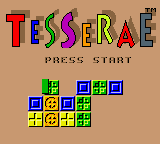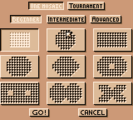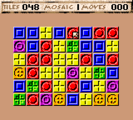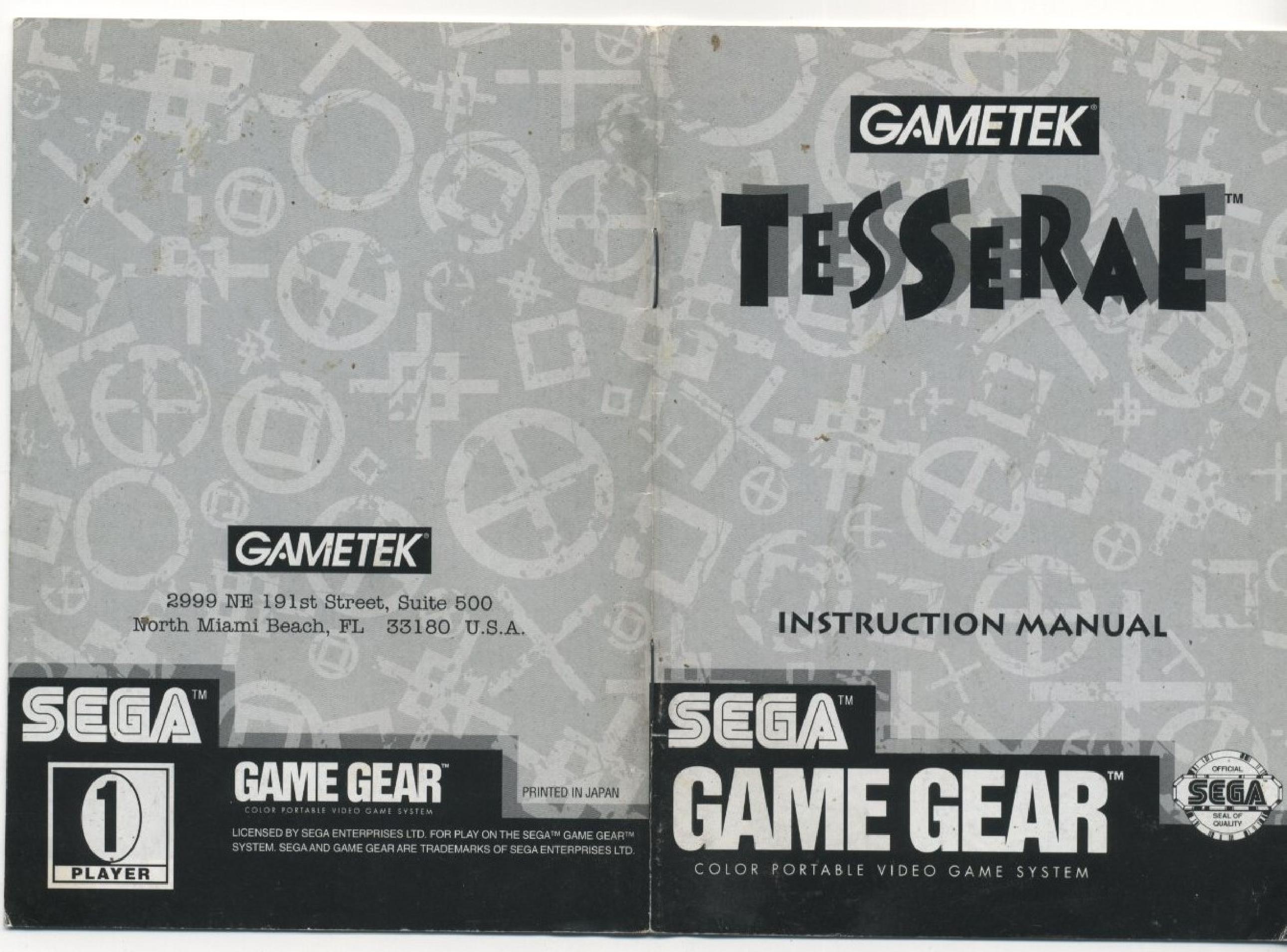Tesserae
From Sega Retro
| Tesserae | ||||||||||
|---|---|---|---|---|---|---|---|---|---|---|
| System(s): Sega Game Gear | ||||||||||
| Publisher: GameTek | ||||||||||
| Developer: Eurocom Entertainment Software | ||||||||||
| Genre: Puzzle | ||||||||||
| Number of players: 1 | ||||||||||
| ||||||||||
|
Tesserae (or Tesseræ) is a puzzle game for the Sega Game Gear. It was only released in North America, although a European release was planned.
Contents
Gameplay
Tesserae is a puzzle game played by flipping colored tiles over other tiles to remove them from the board. While flipping over tiles subtracts the color from the tile that was jumped, landing on a tile adds the colors, making it more difficult for that tile to be removed. Primary tiles of red, blue, and yellow combine to produce secondary tiles of purple, green, and orange. A gray tile is produced by combining all three primary tiles. Tiles also contain shapes, with secondary and tertiary tiles containing the shapes of their constituent primary tiles to aid in identification. The goal of the game is to remove tiles until only one tile remains and to do this in the fewest moves possible.
Tiles can only be moved by jumping over another tile and landing on either another tile or a blank space. Thus, a tile with no adjacent tiles cannot be moved unless another tile is moved next to it, so the player should try to keep the tiles grouped together as closely as possible. Generally, the best strategy is to remove the secondary and tertiary tiles from the corners and the edges of the board first and work toward the inside. It can be advantageous to combine simpler tiles into secondary and tertiary tiles so that they can be removed in fewer moves, but more complex tiles have more rules governing how they can be moved.
The game is played on nine mosaics (boards), which are randomly filled with colored tiles. Mosaics can be played in any order. The player can also choose the Tournament mode, in which all nine mosaics are played in order with the goal of obtaining the lowest overall score. There are three difficulty levels (Beginner, Intermediate, and Advanced), with the higher difficulty levels starting each mosaic with more complex tiles. Beginner only has one secondary tile for every three primarily tiles, Intermediate has one secondary tile for every primary tile, and Advanced has three secondary tiles for every five primary tiles (except the first mosaic, which contains a lower proportion of complex tiles on every difficulty level).
The D-Pad moves a cursor around the screen. Some mosaics are larger than the screen and can be scrolled by moving the cursor to an edge. The player can select a tile with ![]() . When a tile is selected, blinking dots indicate all of the possible moves. The tile can be moved by selecting a valid tile to jump onto, or the move can be canceled by selecting any other spot. The player can undo the last move with
. When a tile is selected, blinking dots indicate all of the possible moves. The tile can be moved by selecting a valid tile to jump onto, or the move can be canceled by selecting any other spot. The player can undo the last move with ![]() . This can be done as many times as desired and incurs no penalty on the player's score. Pausing the game with START shows a short summary of the game's rules and controls.
. This can be done as many times as desired and incurs no penalty on the player's score. Pausing the game with START shows a short summary of the game's rules and controls.
It is possible to create a situation where there are no valid moves left, in which case the game informs the player that the game can be restarted (by pressing START when prompted) or the player can undo the last move.
Rules
Jumping
The following are the rules for jumping over tiles:
- A primary tile can jump over a primary of any color. When this is done, the tile that is jumped over is removed from the board.
- A primary tile can jump over a secondary but only if the primary is a component of the secondary. When this is done, the primary is subtracted from the secondary, leaving a primary tile.
- A primary tile can jump over a tertiary tile. Any primary can jump over a tertiary since the tertiary is composed of every primary tile. When this is done, the primary is subtracted from the tertiary, leaving a secondary tile.
- A secondary tile can jump over an identical secondary. When this is done, the tile that is jumped over is removed from the board.
- A secondary tile can jump over a tertiary tile. When this is done, the secondary is subtracted from the tertiary, leaving a primary tile.
- A tertiary tile can only jump over another tertiary tile. When this is done, the tertiary that is jumped over is removed from the board.
Landing
The following are the rules for landing on tiles:
- A primary tile can only land on a blank space, another primary, or a secondary that does not already contain its color. Landing on a primary of the same color combines the tiles into a single primary tile of the same color. Landing on a primary of a different color combines the tiles into a secondary tile containing both colors.
- A secondary tile can only land on a blank space, a primary that is not already contained in the secondary, or an identical secondary. Landing on a primary combines the tiles into a tertiary tile. Landing on an identical secondary combines the tiles into a single secondary tile.
- A tertiary tile can only land on a blank space or another tertiary. Landing on another tertiary combines the tiles into a single tertiary.
Tiles
| Red, Blue, and Yellow | |
|---|---|
| The primary tiles are Red, Blue, and Yellow. | |
| Green | |
| Green is a secondary tile composed of the Blue and Yellow primary tiles. | |
| Violet | |
| Violet is a secondary tile composed of the Red and Blue primary tiles. | |
| Orange | |
| Orange is a secondary tile composed of the Red and Yellow primary tiles. | |
| Grey | |
| Grey is a tertiary tile composed of the Red, Blue, and Yellow primary tiles. |
Production credits
- Artwork and Programming by: Eurocom
- Producers: Rod Humble, Jim Masterson
- Manual Written by: Jim Masterson, Stacey Ruderman
- Package and Manual Design by: John Tombley
- Production Manager: Sherry Dunnigan
Magazine articles
- Main article: Tesserae/Magazine articles.
Physical scans
| Sega Retro Average | ||||||||||||||
|---|---|---|---|---|---|---|---|---|---|---|---|---|---|---|
|
| 79 | |
|---|---|
| Based on 2 reviews | |
Technical information
ROM dump status
| System | Hash | Size | Build Date | Source | Comments | |||||||||
|---|---|---|---|---|---|---|---|---|---|---|---|---|---|---|
| ? |
|
128kB | Cartridge (US/EU) |
References
NEC Retro has more information related to Tesserae
|
| Tesserae | |
|---|---|
|
Main page | Comparisons | Magazine articles | Reception | |









